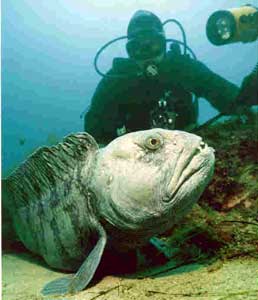 |
| Dr. Paul Bentzen leads a research team that is investigating fundamental questions about the structure of fish populations.(Abriel Photo) |
Dr. Paul Bentzen knows his fish. His office walls are replete with posters depicting myriad fish species, which he´ll point to readily when talking about his research in population and conservation genetics in fish, and conservation biology in general.
Motivated by a deep concern for the current status and future prospects of many fish species, Dr. Bentzen investigates fundamental questions about the structure of fish populations. "Is a species of fish in one place different from the same species of fish in another place, have they adapted differently?" he asks. "These questions have to do with how a population is structured.... To protect fish species at risk, we have to know these things."
Dr. Bentzen´s research team includes six students and focuses primarily on "interesting and weird" non-commercial fish species, selected based on a mix of interesting biological features and conservation needs.
"Everyone knows that fisheries are in trouble," he remarks. "But what´s not as widely known is that it isn´t just the commercially important species, like cod or salmon that are in trouble. Many of them are species we know little about." As in the case of northern wolffish, many of these species are in decline because they get caught in trawls as by-catch, or have their habitats destroyed by trawls.
Dr. Bentzen estimates that generally, there has been a 90 per cent reduction in these fish populations from prior abundance. Genetic analysis is absolutely essential to the protection, and perhaps the revitalization of many fish species. But, he points out, it´s not just a question of whether a whole species is at risk or endangered.
 |
| John Batt, Dalhousie Aquatron Manager, looks on at an Atlantic wolffish, Anarichas lupus. (Photo Copyright 2005 Dr. Chris Harvey-Clark, University of British Columbia, all rights reserved.) |
Often, a species will be declining in one location, while a separate population of the same species thrives in another. Genetic analysis allows researchers like Dr. Bentzen to discern these different populations, to know exactly which ones are in decline. This kind of information helps determine which fish are protected under Canada´s Species at Risk act. While PhD student Megan McClusker focuses on wolffish, two other graduate students, Adam Cook and Kim Murray, work with Atlantic whitefish. At one point, this species travelled between fresh and salt water during its life cycle, but is now found only in several lakes in the Bridgewater, NS, water supply.
"What we´ve been doing is looking at the genetics of these Atlantic whitefish to see if they are a distinct population, and to determine how much genetic variation they have left, compared to other, more abundant whitefish species," explains Bentzen. "We´ve discovered an extremely low level of genetic variation, which means they might be less adaptable to environmental change."
Other work with this species includes experiments at Dalhousie´s Aquatron, to determine their tolerance to salt water, which may have been lost through years trapped in fresh water.
Dr. Bentzen says, "Prior to these experiments, it wasn´t clear whether these fish could still adapt to their ´normal´ environment. Fortunately, the experiments showed that the whitefish still tolerate seawater well. So that´s some good news for this species."
